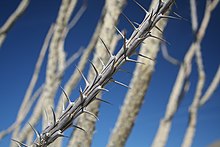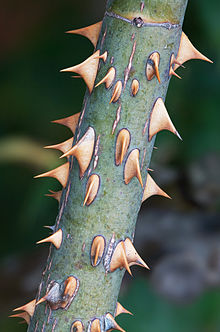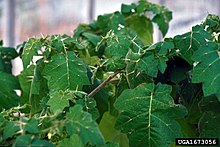Thorns, spines, and prickles: Difference between revisions
| Line 37: | Line 37: | ||
== In human culture == |
== In human culture == |
||
Primitive humans are known to have used thorns as tools. Human history records a variety of cultural references to sharp-pointed plant defensive mechanisms. The [[Book of Genesis]] recounts the creation of thorns as one of the punishments for the sin of Adam and Eve, stating "Thorns also and thistles shall [the ground] bring forth to thee; and thou shalt eat the herb of the field." Genesis, 3:18. One of the most enduring cultural images is the [[Crown of Thorns]] described in the [[Bible]] as having been placed on the head of [[Jesus]] before [[Crucifixion of Jesus|his crucifixion]]. It is mentioned in the [[Gospel]]s of [[Gospel of Matthew|Matthew]] (27:29), [[Gospel of Mark|Mark]] (15:17), and [[Gospel of John|John]] (19:2, 5) and is often alluded to by the early Christian Fathers, such as [[Clement of Alexandria]], [[Origen]], and others. For example, [[John the Evangelist]] states that "the soldiers plaited a crown of thorns, and put it on his head". ([[King James Version|KJV]], ch. 19). The biblical account does not specify what kind of thorns were involved, and leaves no clues from which to determine whether these were biologically classifiable as thorns, spines, or prickles. In modern times, the [[oxygen]] [[isotope]] composition of spines from [[saguaro]] cactus have been shown to record changes in local rainfall and can be used to reconstruct [[climate]] and plant [[ecophysiology]] over the plant's lifetime [[Acanthochronology]]. |
Primitive humans are known to have used thorns as tools. Human history records a variety of cultural references to sharp-pointed plant defensive mechanisms. The [[Book of Genesis]] recounts the creation of thorns as one of the punishments for the sin of Adam and Eve, stating, "Thorns also and thistles shall [the ground] bring forth to thee; and thou shalt eat the herb of the field." Genesis, 3:18. One of the most enduring cultural images is the [[Crown of Thorns]] described in the [[Bible]] as having been placed on the head of [[Jesus]] before [[Crucifixion of Jesus|his crucifixion]]. It is mentioned in the [[Gospel]]s of [[Gospel of Matthew|Matthew]] (27:29), [[Gospel of Mark|Mark]] (15:17), and [[Gospel of John|John]] (19:2, 5) and is often alluded to by the early Christian Fathers, such as [[Clement of Alexandria]], [[Origen]], and others. For example, [[John the Evangelist]] states that "the soldiers plaited a crown of thorns, and put it on his head". ([[King James Version|KJV]], ch. 19). The biblical account does not specify what kind of thorns were involved, and leaves no clues from which to determine whether these were biologically classifiable as thorns, spines, or prickles. In modern times, the [[oxygen]] [[isotope]] composition of spines from [[saguaro]] cactus have been shown to record changes in local rainfall and can be used to reconstruct [[climate]] and plant [[ecophysiology]] over the plant's lifetime [[Acanthochronology]]. |
||
An early popular myth involving a thorn is that of [[Androcles]], a fugitive slave in ancient Greece who was said to have befriended a lion by pulling a thorn from the lion's paw.<ref>Carrington, Norman T., Shaw, George Bernard. Androcles and the Lion: Brodies Notes. Publisher: Macmillan, 1976, ISBN 978-0-330-50050-0</ref> |
An early popular myth involving a thorn is that of [[Androcles]], a fugitive slave in ancient Greece who was said to have befriended a lion by pulling a thorn from the lion's paw.<ref>Carrington, Norman T., Shaw, George Bernard. Androcles and the Lion: Brodies Notes. Publisher: Macmillan, 1976, ISBN 978-0-330-50050-0</ref> |
||
Revision as of 15:08, 24 June 2013
In botanical morphology, thorns, spines, and prickles are hard structures with sharp, or at least pointed, ends. In spite of this common feature, they differ in their growth and development on the plant; they are modified versions of different plant organs, stems, stipules, leaf veins, or hairs. In nontechnical usage, the terms may be synonymous.








Function
Agrawal et al. (2000) found that spines seem to have little effect on pollinators, which the plants need in order to reproduce.[1]
Definitions and technical distinctions
- Thorns are modified branches or stems. They may be simple or branched.
- Prickles are comparable to hairs but can be quite coarse (for example, rose prickles), i.e. they are extensions of the cortex and epidermis.[2][3]
Spinescent is a term describing plants that bear sharp structures that are not necessarily spines, thorns, or prickles in the technical sense. It also can refer to the state of tending to be or become spiny in some sense or degree, as in: "...the division of the African acacias on the basis of spinescent stipules versus non-spinescent stipules..."[4]
Some authors prefer not to distinguish spines from thorns because, like thorns, and unlike prickles, they commonly contain vascular tissue.[5]
Technically speaking, many plants commonly thought of as having thorns or spines actually have prickles. Roses, for instance, have prickles.[5]
Evolution
It has been proposed that thorny structures may first have evolved as a defense mechanism in plants growing in sandy environments that provided inadequate resources for fast regeneration of damage.[6][7] However, the suggestion was unsupported by any argument to discount the likelihood that spiny defences might have been developed as means of defence in say, resource-rich environments where herbivory might have been more intense than in the hypothesized sandy environments.
Not all functions of spines or glochids are limited to defence from physical attack by herbivores and other animals. In some cases, spines have been shown to shade or insulate the plants that grow them (e.g. saguaro cactus spines shade the apical meristem in summer and in members of the Opuntioideae glochids insulate the apical meristem in winter).
Morphological variation
Thorns, spines, and prickles occur in a wide variety of ecologies, and their morphology also varies greatly. They occur as sharpened branches (e.g. in Carissa, Citrus, Crataegus), spiky inflorescences (e.g. in Tylecodon reticulatus),[8] a tiny point at the tip of the leaf (mucronate leaves) (e.g. in Sansevieria),[9] leaves fully converted to spines (e.g. in Opuntia),[10] stipules converted to spines (e.g. in many Acacia), prickles on stems (e.g. of Rosa, Erythrina and Ceiba speciosa), uriticating (i.e. stinging) hairs, bristles, and finely barbed spines called glochids. Some thorns are hollow and act as myrmecodomatia, others (e.g. in Crataegus monogyna) bear leaves. Thorns of some species are branched (e.g. in Crataegus crus-galli, Carissa macrocarpa).
In human culture
Primitive humans are known to have used thorns as tools. Human history records a variety of cultural references to sharp-pointed plant defensive mechanisms. The Book of Genesis recounts the creation of thorns as one of the punishments for the sin of Adam and Eve, stating, "Thorns also and thistles shall [the ground] bring forth to thee; and thou shalt eat the herb of the field." Genesis, 3:18. One of the most enduring cultural images is the Crown of Thorns described in the Bible as having been placed on the head of Jesus before his crucifixion. It is mentioned in the Gospels of Matthew (27:29), Mark (15:17), and John (19:2, 5) and is often alluded to by the early Christian Fathers, such as Clement of Alexandria, Origen, and others. For example, John the Evangelist states that "the soldiers plaited a crown of thorns, and put it on his head". (KJV, ch. 19). The biblical account does not specify what kind of thorns were involved, and leaves no clues from which to determine whether these were biologically classifiable as thorns, spines, or prickles. In modern times, the oxygen isotope composition of spines from saguaro cactus have been shown to record changes in local rainfall and can be used to reconstruct climate and plant ecophysiology over the plant's lifetime Acanthochronology.
An early popular myth involving a thorn is that of Androcles, a fugitive slave in ancient Greece who was said to have befriended a lion by pulling a thorn from the lion's paw.[11]
The status of the Scottish Thistle as the national emblem of Scotland is founded on the story (recounted here) that an invading Norse army attempting a night attack was betrayed when they encountered a thistle in the dark.
Plants bearing thorns, spines, or prickles are often used as a defense against burglary, being strategically planted below windows or around the entire perimeter of a property.[12]
They also have been used to protect crops and livestock against marauding animals. Examples include hawthorn hedges in Europe, Agaves in the Americas and in other countries where they have been introduced, Osage Orange in the prairie states of the US, and Sansevieria in Africa.[13]
See also
References
- ^ Agrawal, A, A., Rudgers, A, J., Botsford, W, L., Cutler, S., Gorin, B, J., Lundquist, C, J., Spitzer, W, B., & Swann, L, A. (2000). Benefits and Constraints on Plant Defense against Herbivores: Spines Influence the Legitimate and Illegitimate Flower Visitors of Yellow Star Thistle, Centaurea solstitialis L. (Asteraceae). JSTOR, 45(1), 1-5. http://www.jstor.org/stable/3672545. retrieved 2012-03-20
- ^ Van Wyk, Braam (2007). How to Identify Trees in Southern Africa (illustrated ed.). Struik. p. 184. ISBN 1-77007-240-3, 9781770072404.
{{cite book}}: Check|isbn=value: invalid character (help) - ^ Sengbusch, Peter (2003-07-31). "Cross-Section Through the Prickle of a Rose". Retrieved 2009-04-27.
- ^ Ross, J. H. "A conspectus of the African Acacia species." Series: Memoirs of the Botanical Survey of South Africa, No. 44 Botanical Research Institute, Dept. of Agricultural Technical Services, Pretoria, 1979
- ^ a b Bell, A.D. 1997. Plant form: an illustrated guide to flowering plant morphology. Oxford University Press, Oxford, U.K. preview in google books
- ^ Steve Brill, Evelyn Dean, Identifying and Harvesting Edible and Medicinal Plants (1994), p. 17.
- ^ August Weismann, John Arthur Thomson, Margaret R. Thomson, The Evolution Theory (1904), p. 124.
- ^ Bihrmann.com
- ^ Dyer, R. Allen, “The Genera of Southern African Flowering Plants”, Vol 2. ISBN 0-621-02863-0, 1976
- ^ Anderson, Edward F., The Cactus Family, Pub: Timber Press 2001 ISBN 978-0-88192-498-5
- ^ Carrington, Norman T., Shaw, George Bernard. Androcles and the Lion: Brodies Notes. Publisher: Macmillan, 1976, ISBN 978-0-330-50050-0
- ^ Marcus Felson, Crime and Nature (2006), p. 288.
- ^ Hunter, J. A., "Hunter" Publisher: Buccaneer Books, 1993, ISBN 978-1-56849-109-7
- Esau, K. 1965. Plant Anatomy, 2nd Edition. John Wiley & Sons. 767 pp.
- Llamas, K. A. 2003. Tropical Flowering Plants. Timber Press, Portland. 423 pp.
External links
 Texts on Wikisource:
Texts on Wikisource:
- Reynolds, Francis J., ed. (1921). "Thorn (plant)". Collier's New Encyclopedia. New York: P. F. Collier & Son Company.
- "Thorn". The New Student's Reference Work. 1914.
